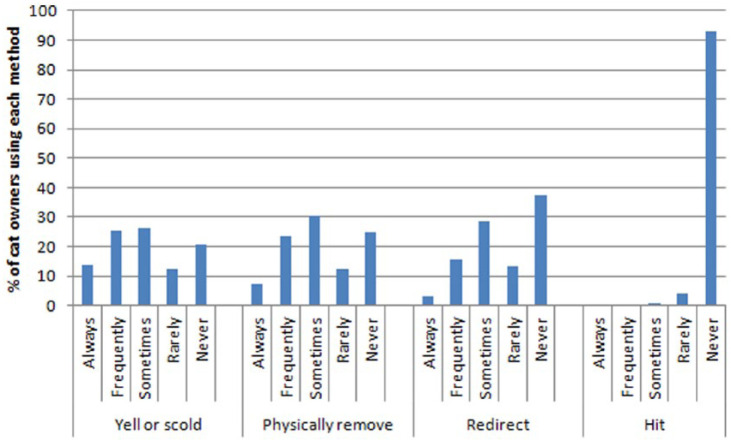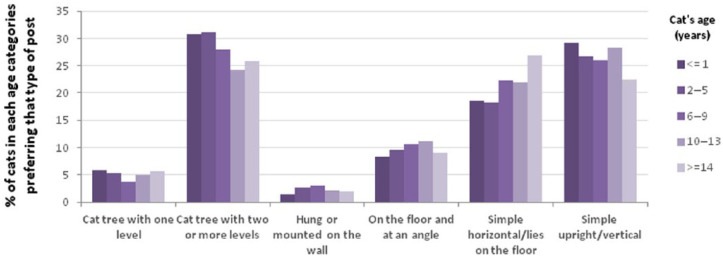Abstract
Objectives
This study was performed to examine aspects of the cat, environment and scratching post that might influence scratching behavior, in an effort to determine how inappropriate scratching behavior might be refocused on acceptable targets.
Methods
An internet survey, posted on several public websites, gathered details about scratching behavior, as described by owners in their home environments, from 4331 respondents over a 4 month period. Responses from 39 different countries were analyzed, mostly from the USA, Canada and the UK.
Results
Owners offered traditionally recommended scratching substrates including rope, cardboard, carpet and wood. Rope was most frequently used when offered, although carpet was offered most commonly. Most owners provided at least one scratching post; cats scratched the preferred substrate more often when the post was a simple upright type or a cat tree with two or more levels and at least 3 ft high. Narrower posts (base width ⩽3 ft) were used more often than wider posts (base width ⩾5 ft). Intact or neutered cats (males and females) were as likely to scratch inappropriately, and inappropriate scratching decreased with age. Geriatric cats between the ages of 10 and 14 years preferred carpet substrate most frequently; all other ages preferred rope first. Inappropriate scratching decreased as the different types/styles of posts increased in the home. Inappropriate scratching did not increase if the number of cats or dogs increased in the household. Declawed cats were preventatively declawed most often to prevent household item destruction.
Conclusions and relevance
Although cats can have individual preferences, our data provide a starting point for veterinarians recommending scratching posts to clients.
Introduction
The domestic cat is currently the most common pet in the world, and 30% of US households own at least one cat.1–3 This may be due, in part, to their small size, relatively low maintenance and space requirements, and their adaptability to a variety of environments. Indoor confinement can result in undesirable behaviors, such as spraying, scratching furniture, etc. Although very rarely reported to veterinarians, scratching is the second most common behavioral complaint of pet owners, with 60% of owners reporting it as problematic.4–7 Consequently, there is a growing need for veterinarians to provide counseling on the prevention and management of this undesirable behavior.
Scratching is a normal feline behavior that serves a variety of purposes, including chemical and visual marking, external nail sheath sharpening and removal, and stretching of the claws and forelimbs, especially after rest.5,6 Marking behaviors, including scratching, increase in response to stress, such as social tension with other cats or changes in the household.5,8 Such destructive behaviors can frustrate pet owners, who often resort to punishing the cat. This further increases anxiety, resulting in an exacerbation of the inappropriate scratching behavior. Historically, veterinarians have advised owners to address this problem by any of a number of methods, including providing scratching posts, training them to use such posts, clipping nails, plastic nail coverings or onychectomy. Scratching of furniture is the primary reason that owners choose to declaw their cats, with 86% presenting their cat for declaw due to household damage.5,9
Onychectomy is a controversial procedure. It provides a solution for furniture scratching and clawing injuries that may save many cats from relinquishment.4,5,10 However, it presents a welfare issue and is illegal in many jurisdictions. While there are no scientific data showing that declawing contributes to an increase in undesirable behavior, declawing subjects the cats to surgery, amputation, discomfort and pain for what is essentially a normal behavior. 4
Most veterinarians will advise owners to provide a scratching post as an outlet for scratching behavior. 11 A recent study demonstrated that when a scratching post is present, the cats use it. 11 However, research to identify the most appealing scratching post for the cat is lacking.
Therefore, we examined aspects of the cat, the environment, and the scratching post or object itself that might influence scratching behavior, in an effort to determine how undesirable scratching behavior might be refocused onto acceptable targets. By determining what the most desirable outlets for scratching behavior are, these findings can improve the welfare of the pet and strengthen the pet–owner bond, by removing a potential cause for punishment and onychectomy, and effectively managing one of the most commonly reported undesirable behaviors of owned cats.
Materials and methods
Questionnaire
A multiple choice survey questionnaire was designed for internet distribution (www.surveymonkey.com/s/catscratch2013). The survey included 27 questions inquiring about owners’ observations of their cats’ scratching behaviors. The questions were presented in a multiple choice format, with options to enter additional comments for some questions. Pictures were used to clarify types and styles of posts and substrates. The survey was made available on the University of California-Davis School of Veterinary Medicine, Clinical Animal Behavior Service social media sites, and shared by the authors via social media (eg, veterinary, humane societies, animal shelters, journalists, rescue organizations and cat breeders). Respondents provided demographic information on their cats, and answered descriptive questions about their scratching posts, unacceptable objects or areas their cats scratched in the home and any strategies owners used to either discourage or encourage any scratching behavior. See the supplementary material for the survey.
Exclusion criteria included the following: respondents who were not the primary caregiver of the cat; those who did not indicate any favored scratching post by their cat (also including those having no scratching post at home); and those reporting that their cat was declawed.
Statistical analysis
For each question, the following univariate descriptive statistics were supplied: number of missing data, absolute and relative frequencies per class. The relationships between questions were investigated with bivariate descriptive analysis and proportions were compared by the two-tailed χ2 test. When necessary, subgroup analyses were performed. P values <0.05 were considered significant, and all tests were two-tailed. All statistical tests were performed using computer software (SAS version 9.3; SAS Institute Inc).
Results
Of the 4164 of surveys returned, 4105 respondents were included in the analyzed population as meeting inclusion criteria. Respondents from 36 countries completed the surveys, with the majority being from the USA (n = 3021; 73.6%), Canada (n = 356; 8.7%) and the UK (n = 91; 2.2%).
Demographics
Most cats were male castrated (n = 2007; 48.8%) or female spayed (n = 1872; 45.6%), with the remaining being female intact (n = 120; 2.9%) and male intact (n = 81; 1.9%). The most common age group was 2–5 years (n = 1433; 34.9%) followed by 6–9 years (n = 1083; 26.4%), 10–13 years (n = 708; 17.2%) and <1 year (n = 499; 12.2%), and cats ⩾14 years of age comprised the lowest population of the group (n = 357; 8.7%).
Appropriate scratching (acceptable target)
Although all respondents had at least one scratching post at home in our analyzed population (n = 4105), most respondents offered several posts (n = 2709; 83.0%), occasionally more when owning several cats (Figure 1). Most of the cats used their preferred post at least daily or multiple times per day (n = 2987; 89.3%). The amount of time spent inside the home by cats significantly affected their frequency of using the post: 75.7% of cats living permanently indoors scratched on their post multiple times per day vs 69.6% for those having outdoor access (P = 0.0006). Conversely, it made no difference on their inappropriate scratching in the home (52.5% of 3004 cats living 100% indoors vs 51.5% of 1059 cats living 0–99% indoors) (P = 0.57).
Figure 1.
Total number of scratching posts available according to the number of cats in the household
Substrate information
Carpet was the most frequently offered substrate; cats most often used rope (sisal) when it was available (Figures 2 and 3). Furthermore, use of scratching posts and use of rope as the preferred substrate increased with an increasing number of posts in the home.
Figure 2.
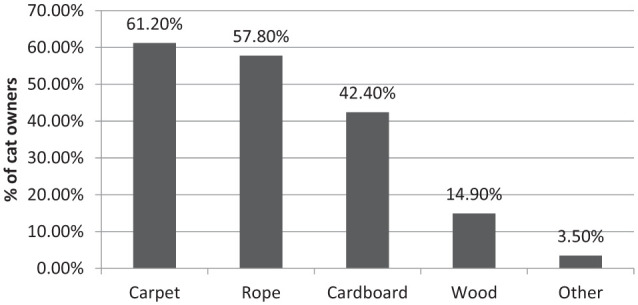
Substrates on scratching posts present in the home (n = 4105)
Figure 3.
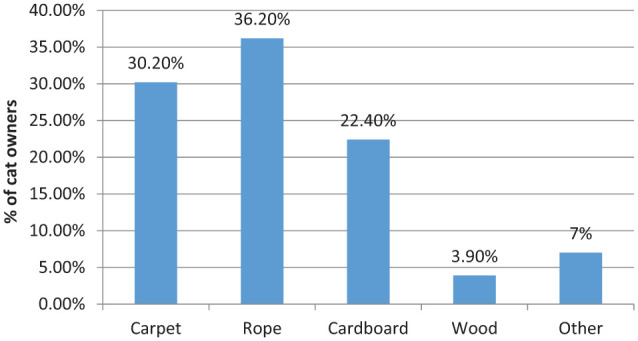
Most used substrate on scratching posts (n = 3376)
Cats ⩽9 years old most often preferred a rope substrate (32.5%), followed by carpet (25.1%) and cardboard (18.2%). Cats >10 years old preferred carpet most often (24.7%), followed by rope (22.9%) and cardboard (19.6%).
Objects/posts
Most respondents offered cats simple vertical posts or cat trees with two or more levels (Figure 4). Cats most often used cat trees with two or more levels and simple vertical posts. Cat trees with one level and hanging or mounted on the wall were the least used (Figure 5).
Figure 4.
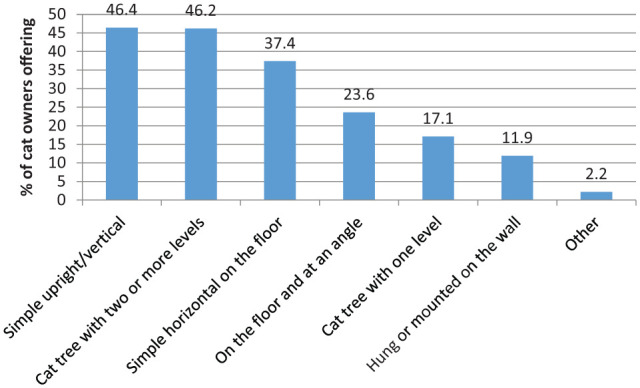
Types of scratching posts present in the home (n = 4105)
Figure 5.

Types of scratching posts used most often (n = 3344)
Cats ⩽9 years old most often preferred cat trees with two or more levels (n = 758; 75.8%) followed by simple vertical posts (n = 680; 69.0%), simple horizontal on the floor (n = 497; 49.5%), on the floor at an angle (n = 247; 24.0%), other (n = 160; 15.8%) and hung or mounted on the wall (n = 64; 5.8%). Cats >10 years old preferred the vertical posts most often (n = 155; 21.9%), followed by cat trees with two or more levels (n = 133; 18.8%), simple horizontal/lies on the floor (n = 120; 16.9%), on the floor and at an angle (n = 61; 8.6%), other (n = 40; 5.7%) and hung or mounted on the wall (n = 12; 1.7%).
Cats most often used narrower (⩽3 ft wide; 88.1%), rather than wider (>3 ft wide; 9.1%) posts (no answer for 2.8%). Similarly, cats most often used shorter (⩽3 ft high; 60.2%) rather than taller (>3 ft high; 36.3%) posts (no answer for 3.5%).
Inappropriate scratching (unacceptable target)
Fifty-two percent of owners observed inappropriate scratching from their cat (n = 2125/4105). Among them, 65.0% of respondents’ cats (n = 1382) exhibited inappropriate scratching at least once per day, with 35.4% (n = 752) exhibiting inappropriate scratching multiple times per day. Most of these respondents had a scratching post offered in the same room as the inappropriately scratched object or area (69.3%). Most often the scratching post or object was located quite close to that area, with 49.3% of them located 1–5 ft away from the inappropriately scratched object or area.
Inappropriate scratching behavior was associated with the original source of the cat: those obtained from a breeder (n = 343) reported significantly less inappropriate scratching (38.2%) than those acquired from any other source (53.6%, n = 3723) (P <0.0001). Conversely, cats obtained from a shelter or rescue (n = 1699) displayed significantly more inappropriate scratching (55.1%) than cats from any other origin (n = 2367; 50.2%) (P = 0.0022). This suggests a positive effect the breeder’s environment may have on the development of the cat and the potential negative impact a rescue environment could have on the prevalence of marking behaviors.
Substrates
Inappropriate scratching was reported the least frequently when owners had rope as a substrate on the preferred scratching post (n = 659; 53.7%), followed by cardboard (n = 456; 60.2%), carpet (n = 645; 63.1%) and wood (n = 85; 64.4%), and ‘other’ was chosen least often (n = 166; 69.7%)
Object/posts
Cat trees with one or more levels were the posts associated with the least inappropriate scratching reported (n = 622/1125; 55.3%) compared with any other types (n = 1389/2219; 62.6%) (P <0.0001), whereas those hung or mounted on the wall were associated with the most inappropriate scratching (n = 60/81; 74.1%) (Figure 6).
Figure 6.
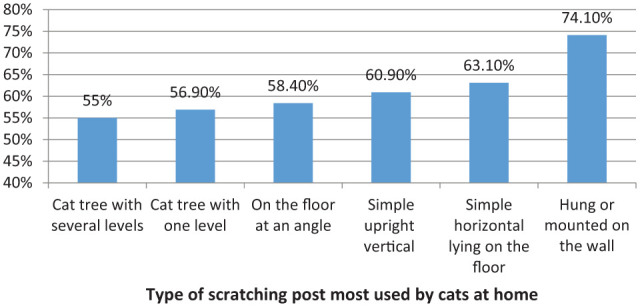
Incidence of inappropriate scratching compared with the scratching post most used by cats at home (n = 3344)
Unlike appropriate scratching post preferences, cats exhibited inappropriate scratching significantly less frequently when the posts offered were >3 ft high (n = 671/1215; 55.2%) compared with smaller posts (n = 1301/2012; 64.7%) (P <0.0001) (Figure 7).
Figure 7.

Incidence of inappropriate scratching according to the height of the post most used by cats at home (n = 3344)
Having up to seven posts in the home was associated with inappropriate scratching in 60.2% of homes (40.1–64.8%), and having >10 posts was related to inappropriate scratching in 32.4% of the cases. Additionally, frequency of scratching post use did not affect the frequency of inappropriate scratching (P = 0.18).
Rewards vs punishment by owners
Respondents who rewarded their cat by any means (ie, food treat, verbal praise and/or pet or stroke) were more likely to report that their cat used their preferred post at least once daily (n = 2366/2942; 80.4%) than those that were never rewarded for scratching (n = 201/297; 67.7%) (P <0.0001). Conversely, when seeing their cat scratching on inappropriate objects or areas in the home, the majority of the respondents verbally reprimanded, physically removed or redirected their cat, but rarely reported hitting their cat (Figure 8). None of these methods appeared to affect the frequency of inappropriate scratching displayed by the cat.
Figure 8.
Punishment methods for cats’ inappropriate scratching (n = 2125)
Number of cats in the home
Respondents with a single cat did not differ in the frequency of reporting inappropriate scratching than respondents with more than one cat in the home (n = 625/1115 [56.1%] and n = 1462/2678 [54.6%], respectively [P = 0.41]). Sexual status (intact vs neutered) was not related to frequency of inappropriate scratching (P = 0.07).
Declaw status
Three hundred and eighty-six respondents reported that their cat was declawed: 348 (8.5%) reported their cat was declawed in the front paws only and 38 (0.9%) reported their cats were declawed both in the front and back paws. Those 386 respondents, excluded from the study analysis, revealed their cats were declawed mostly to prevent damage to objects in the house (n = 133; 34.5%), to prevent injury to people (n = 68; 17.6%), to prevent injury to other pets (n = 43; 11.1%), to prevent unspecified damage (n = 37; 9.6%) and, lastly, because a previous cat had caused damage (n = 21; 5.4%). Some respondents (n = 112; 29.0%) obtained the cat already declawed.
Discussion
Our study confirms that inappropriate scratching by cats is recognized by owners and that owners offer traditionally recommended substrates and types and styles of posts but do not necessarily offer the substrate or style most commonly preferred by cats. Our results provide evidence for cats’ substrate and style preferences, which could affect the advice offered by veterinarians to clients seeking to alter inappropriate scratching behavior. Our data also revealed that the reporting of inappropriate scratching was not negatively associated with an increasing number of posts in the home, and inappropriate scratching decreased as the width of the post base increased.
Our findings compliment a previous study demonstrating that cats use scratching posts when provided for them. 11 Additional findings reveal that most owners offer scratching posts that are simple upright vertical or cat trees with two or more levels. In our study, inappropriate scratching was reported significantly less often when cats had access to cat trees with one or more levels or when scratching posts (any type) were 3 ft or higher (10% less unwanted scratching). However, even when a scratching post was provided in the same room as the location of inappropriate scratching, this unwanted behavior was still reported by almost 70% of the owners. This was despite the post being often located quite close to the inappropriately scratched object or area.
Older cats preferred a softer carpet substrate over a harder rope substrate. Cats ⩽9 years old and ⩾14 years old preferred cat trees with one or more levels followed by simple upright vertical posts, whereas cats between 10 and 13 years of age preferred simple upright vertical first, followed by cat trees with two or more levels (Figure 9).
Figure 9.
Preferred scratching post types according to cats’ ages
These results are consistent with the possibility that older cats suffer more frequently with medical issues such as arthritis. They might also rest more, be less active and perhaps less agile than younger cats, which are more exploratory in nature. Older cats are also more likely to be well established in their homes, which could result in less of a need to mark the territory visually or chemically
Animals that are positively rewarded for a behavior are more likely to repeat the behavior and, if positively punished, less likely to repeat any behavior. 12 This is consistent with our findings as respondents reported more frequent use of the appropriate scratching post when they positively rewarded their cats’ appropriate scratching behavior. Conversely, neither positive nor negative punishment (removing the cat from the inappropriate object being scratched) made a difference in the frequency of inappropriate scratching reported in our study.
With regard to age, sex, neuter status and breed of cats, and the associations with inappropriate scratching, our findings were that not only was the scratching behavior of both neutered males and females similar, but also, surprisingly, that entire males and females did not scratch significantly more on inappropriate objects than neutered cats. Most respondents owned neutered cats aged between 2 and 5 years of age and the number of respondents who owned entire cats in general was very small. This could represent the typical population of client-owned cats.
As reported by several previous studies, owners choose to declaw their cats most frequently to prevent household damage.5,11,13
Some respondents omitted some answers in their survey. It is our opinion that it would be reasonable to include answers/data from any question, even if the same respondent omitted answers to other questions in their particular survey and that the information they did provide was valuable. Different subpopulations were considered as being more logical and preventing too many missing data: mostly the 3344 respondents with cats having a preferred post and the 2125 respondents with inappropriate scratching for related questions, respectively. Statistical analysis accommodated for any discrepancies giving a percentage and frequency number for true comparison in each case.
Using an internet-based survey to reach out to pet owners who have a special interest in cats is a convenient sample and thus less randomized; however, it would be reasonable to generalize the information gathered to all cat owners. Additional drawbacks to internet-based surveys could include respondents who are biased towards their own personal preferences, skipped questions or gave dishonest answers. In our survey we included pictures in order to clarify substrates and types or styles of posts, but these could not represent every possibility available. When using an internet survey it is not possible to address any questions from a respondent. Internet-based surveys are convenient, inexpensive and can have a high response rate leading to the accumulation of data in a short period of time.
Conclusions
The ideal scratching post to recommend to a cat owner to help prevent inappropriate scratching is one that includes rope as a substrate, is upright vertical, 3 ft or higher, has two or more levels and a base width of between 1 and 3 ft. Although cats can have individual preferences, our data provide a starting point for veterinarians to recommend specific scratching posts to clients as a first best choice. However, our results also illustrate that if offering a particular type of post is not related to a decrease in inappropriate scratching behavior, other types and styles should be explored or considered. Owners who reward their cat for scratching the desired post, or motivate their cat with natural supplements, can increase their cat’s use of the appropriate target.
Supplemental Material
Cat scratching survey 2013
Acknowledgments
Thanks to Adam Smythe who contributed significantly to the data analysis, and to Dr Mark Rishniw for his advice and guidance in editing and article submission.
Footnotes
Supplementary material: Cat scratching survey 2013.
The authors do not have any potential conflicts of interest to declare.
Funding: This research received no specific grant from any funding agency in the public, commercial or not-for-profit sector, except for the data analysis which was carried out at CEVA Santé Animale.
Accepted: 9 June 2015
References
- 1. Turner DC, Bateson P. The domestic cat: the biology of its behaviour. 3rd ed. Cambridge: Cambridge University Press, 2014. [Google Scholar]
- 2. Bradshaw J. Cat sense. New York: Basic Books, 2012. [Google Scholar]
- 3. American Veterinary Medical Association. Total pet ownership and pet population. In: U.S. Pet Ownership and Demographic Sourcebook. Schaumburg, IL: 2012, pp 1–34. [Google Scholar]
- 4. Patronek GJ. Assessment of claims of short-and long-term complications associated with onychectomy in cats. J Am Vet Med Assoc 2001; 219: 932–937. [DOI] [PubMed] [Google Scholar]
- 5. Beaver BV. Feline behavior: a guide for veterinarians. 2nd ed. St Louis, MO: Elsevier Science, 2003, pp 115–119. [Google Scholar]
- 6. Heidemberger E. Housing conditions and behavioral problems of indoor cats as assessed by their owners. Appl Anim Behav Sci 1997; 52: 345–364. [Google Scholar]
- 7. Morgan M, Houpt KA. Feline behavior problems: the influence of declawing. Anthrozoos 1989; 3: 50–53. [Google Scholar]
- 8. Casey R. Management problems in cats. In: Horwitz DF and Mills DS (eds). BSAVA manual of canine and feline behavioural medicine. 2nd ed. Gloucester: BSAVA, 2009, pp 98–110. [Google Scholar]
- 9. Yeon SC, Flanders JA, Scarlett JM, et al. Attitudes of owners regarding tendonectomy and onychectomy in cats. J Am Vet Med Assoc 2001; 218: 43–47. [DOI] [PubMed] [Google Scholar]
- 10. Landsberg GM. Feline behaviour and welfare. J Am Vet Med Assoc 1996; 208: 502–505. [PubMed] [Google Scholar]
- 11. Mengoli M, Mariti C, Cozzi A, et al. Scratching behaviour and its features: a questionnaire-based study in an Italian sample of domestic cats. J Feline Med Surg 2013; 15: 886–892. [DOI] [PMC free article] [PubMed] [Google Scholar]
- 12. Herron M, Shofer FS, Reisner I. Survey of the use and outcome of confrontational and non-confrontational training methods in the client owned dogs showing undesirable behaviors. Appl Anim Behav Sci 2009; 117: 47–54. [Google Scholar]
- 13. Landsberg G. Feline scratching and destruction and the effects of declawing. Vet Clin North Am Small Anim Pract 1991; 21: 265–278. [DOI] [PubMed] [Google Scholar]
Associated Data
This section collects any data citations, data availability statements, or supplementary materials included in this article.
Supplementary Materials
Cat scratching survey 2013




